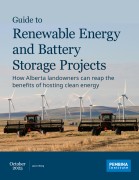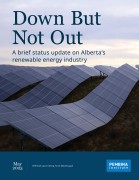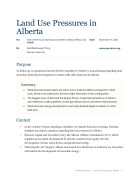October 29, 2002
The Honourable Ralph Klein
Premier
Government of Alberta
Office of the Premier
307 Legislature Building
10800-97 Avenue
Edmonton, AB
T5K 2B7
Dear Premier Klein,
Estimated at over 10,000 MW of power capacity, Alberta offers some of the best low-impact renewable energy resources in the world. The signatories of this letter share a vision for Alberta to become the Canadian leader in the development of these resources.1
To realize this vision, the Alberta Government must advance low-impact renewable energy through a variety of policy and market mechanisms that will facilitate its full development in the Alberta electricity market. Such mechanisms must impose little or no additional cost on electricity consumers and must take full advantage of federal incentives for renewable energy.
With such policies in place, we believe that the marketplace will attract significant investment for renewable energy projects, money that would otherwise go to jurisdictions offering superior market environments.
We are aware that the Clean Air Strategic Alliance Electricity Project Team is currently looking into options for addressing emissions from the electric power sector and that they may be recommending policy mechanisms for renewable energy as part of their final report expected in June 2003. In addition, we acknowledge that the Alberta government's recently announced climate change action plan includes some new policies to support renewable energy.
Nonetheless, we remain concerned that Alberta is currently not well positioned to capitalize on "clean-energy" markets, which are predicted to grow from US $7 billion in the year 2000 to US $82 billion in 2010.2 By implementing the following proposed policy recommendations, investment in renewable energy facilities in Alberta could be $3 billion dollars by 2010, with Alberta poised to attract new industrial manufacturing infrastructure, federal incentive funds, and other benefits.
- We recommend that the Alberta government work with electricity generators and/or retailers to establish a legally binding provincial target for low-impact renewable energy development equivalent to 5% of the province's electricity supply in 2008 and 10% in 2012. This would allow Alberta to attract new investments in manufacturing capacity for renewable energy equipment.
We commend the Alberta Government for its commitment to set a goal for increasing the renewable and alternative energy portion of total provincial energy capacity by 3.5% (560 MW) by 2008. Identifying a renewable energy target is an important first step in re-establishing Alberta as a leader in renewable energy. We understand that the specific framework for reaching this target will be established by the Clean Air Strategic Alliance Electricity Project Team. Those of us who are members of that team will work constructively to develop mechanisms to implement such a renewable energy target. However, we also will advocate that the proposed target should be increased given the substantial renewable energy resources in the province, should apply to renewable energy only (i.e., separate target established for "alternative" energy), should be linked to electricity production rather than capacity, and should be a legally binding mechanism.
Our recommended target is equivalent to about 7,200 GWh of annual electricity supply. Existing renewable energy facilities could contribute toward this target. A mechanism for "Low-Impact Renewable Energy Certificate" trading could be developed to reduce the overall cost of meeting the target, an approach practiced in Texas. Electricity retailers would be free to meet the target through whatever mechanism works best for them. For example, green power marketing could meet a proportion of the standard, taking advantage of the new federal green power "Market Incentive Program." Remaining obligations could be met through strategic investments in low-impact renewables with the costs shared among all consumers. Such a portfolio standard has been proposed in Ontario, Nova Scotia, and British Columbia.
The benefits of such a provincial target would be significant, helping to pave the way for significant economic growth. It would trigger access to the Wind Power Production Incentive (WPPI) and other federal incentives for renewables. It would allow Alberta to reduce its greenhouse gas emissions by nearly 4 million tonnes per year. And it would help to level the playing field in the energy market by providing recognition for the environmental and social benefits of renewables.
- To support the achievement of the target, we recommend that the Alberta government procure a minimum of 50% of the provincial government's total electricity load and a proportion of its thermal energy needs from renewable energy by 2010.
We acknowledge the Alberta government's recent commitment to purchase 10% of the provincial government's electricity needs from green power. However, we believe that Alberta should adopt a stronger target, one that goes beyond the existing federal government commitment of 20%. Implementing this recommendation would reflect Alberta's leadership and allow access to federal funds through the WPPI and Renewable Energy Deployment Initiative. Not only would this reduce the government's contribution to provincial emissions, it would also provide a strong signal to other energy consumers in the province that investing in renewable energy is important.
- We recommend that electricity source and emission labelling be displayed on power bills.
We acknowledge the Alberta government's recent commitment to require electricity retailers to disclose the emissions intensity of the electricity they market to consumers. We believe that electricity sources should also be disclosed. Similar to consumer food labels, these labels would indicate the sources of electricity and the environmental impacts of those sources, facilitating consumer choice in the purchase of low-impact energy sources.
- We recommend that the Alberta government establish a power banking ("net metering") policy, which would encourage private investments in renewable energy.
Such a policy would allow small renewable electricity generators to bank any excess electricity that they provided to the grid. Power banking would significantly benefit rural Albertans who have access to significant renewable energy resources such as wind and biogas, yet cannot establish a financially optimal facility size because of the lack of storage that would permit full utilization of the resources. In addition, power banking would significantly reduce the cost of distributed renewables, with little or no cost to other electricity consumers. This type of program is already established in the Yukon, Manitoba, Toronto, rural Ontario, Nova Scotia, and the majority of jurisdictions in the United States.
- We recommend that the Minister of Municipal Affairs immediately review municipal tax assessment procedures on renewable energy projects, and that the Alberta government work with municipal governments to adopt a revenue-neutral formula for municipal tax assessment that is based on energy project revenues.
Currently, municipal tax is assessed on the capital assets of an energy project. This creates a discontinuity between fossil fuel and renewable energy resources, which have different proportions of total costs within the capital assets.
In our view, the challenge will be for Alberta to keep pace with the extensive policy development occurring in other jurisdictions in the race to attract investment dollars and federal incentives. For example,
- BC Hydro has committed to meet 10% of their new demand from new green electricity sources, targeting 800 GWh of electricity supply in 2003 alone, equivalent to the needs of 80,000 homes. The BC Energy Policy Task Force has recommended that the government include a legislated "portfolio standard," which would maintain this commitment into the future for all power suppliers.
- Nova Scotia has established a 100 GWh target for wind power and, after they have acquired this wind, will consider adopting a portfolio standard in the future.
- Québec has established a target of 1000 MW of new wind energy capacity and 200 MW of forest biomass power by 2012.
- Ontario Power Generation has committed to purchase 3000 GWh of wind capacity by 2005.
- Yukon Development Corporation provides a "production incentive" to renewable power producers.
- The State of Texas requires retailers to derive 3% of their electricity needs from renewable energy by 2009, equivalent to 2000 MW of new wind capacity.
- The United States Senate has just passed a bill stipulating that 10% of the country's electricity supply come from new renewable energy sources by 2020.
We invite the Alberta Government to position Alberta as the Canadian leader in advancing renewable energy through new policy initiatives based on our recommendations as outlined above.
We would be pleased to provide further documentation on our recommendations upon request. In addition, we would be interested in meeting with you to discuss ways we can work together to enhance the Alberta Advantage by establishing the leading investment climate in North America for low-impact renewable energy.
Sincerely,
Locke Boros, Lake Wabamum Enhancement and Protection Association
7604-151 Street, Edmonton, AB T5R 1H4
Gordon Howell, Director, Canadian Solar Industries Association
Howell-Mayhew Engineering Inc. 15006-103 Avenue, Edmonton, AB T5P 0N8
Myles Kitagawa, Toxics Watch Society
10125 97 Ave NW, Edmonton, AB T5K 0B3
Sonja Mihelcic, Sierra Club, Prairie Chapter
10125-97 Avenue, Edmonton, AB T5K 0B3
Guy Painchaud, Canadian Wind Energy Association
100, 3553-31st Street N.W., Calgary, AB T2L 2K7
Brian Staszenski. Destination Conservation
10511 Saskatchewan Drive, Edmonton, AB T6E 4S1
Andrew Pape-Salmon, Pembina Institute
Box 7558, Drayton Valley, AB T7A 1S7
Cc: Minister Lorne Taylor, Minister Murray Smith, Minister Guy Boutilier
1These energy resources are non-depletable; produce zero net greenhouse gas emissions, and low or zero other air emissions; have minimal impacts on watersheds, landscapes, and biodiversity; and do not contribute to toxic waste build-up. Examples include electricity derived from wind power, photovoltaic solar power, low-impact hydro-electricity, and low-emission biomass and biogas energy.
2Clean Edge Inc., Joel Makower and Ron Pernick. Clean Energy Markets: Five Trends to Watch in 2002. January, 2002.
Download the briefing note Clearing the Air with Renewable Energy
Download the backgrounder Enhancing Sustainable Economic Development in Canada with Renewable Energy





